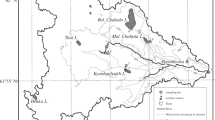Abstract
The surface water chemistry of Høylandet has beenstudied by performing two synoptic surveys, duringhigh runoff in the autumn of 1986 and during a lowflow period in the summer of 1988. Based on watersamples of up to 38 chemical variables from 75 sites,analyses show considerable variation in the chemicalcomposition. There is a strong altitude gradient, i.e.very dilute poorly buffered waters dominate at higherelevations near the timberline while progressivelyhigher salt content and alkalinities arecharacteristic at lower altitudes more dominated byforests. The influence of mires is less pronounced.The overall water quality is of oligotrophic naturewith low concentrations of strong acid anions andmetals known to be enriched under acidifiedconditions. The natural pH gradients are considerablebut with no indication of anthropogenic acidification.The data provide little support for the hypothesisthat in-catchment production of organically derivedacidity leads to acid runoff, which in thesecatchments appears compensated by increasedweathering. The findings are in general accordancewith other Høylandet catchment studies. It isconcluded that this area may serve as a representativepristine surface runoff analogue for catchmentscurrently affected by atmospheric deposition of strongmineral acids.
Similar content being viewed by others
References
Anderson, H. A., J. D. Miller, R. C. Ferrier, T. A. Bruce Walker, D. C. Bain, R. G. McMahon, A. Hepburn, M. Stewart, B. F. L. Smith & J. S. Anderson, 1997. The effects of boreal vegetation and the podzolic soils on hydrochemistry at Høylandet (mid-Norway), Hydrobiologia 348: 5–17.
Environment Canada, 1990. The Candian Long-Range Transport of Air Pollutants and Acid Deposition Assessment Report. Part 4, Aquatic effects, Ottawa, Canada, 151 pp.
Baker, J. P., D. P. Bernard, S. W. Christensen, M. J. Sale, J. Fred, K. Heltcher, D. Marmorek, L. Rowe, P. Scanlon, G. Suter, W. Warren-Wicks & P. Welbourn, 1990. Biological Effects of Changes in Surface Water Acid-Base Balance Chemistry. NAPAP Report 13. In National Acid Precipitation Assessment Program, Acidic Deposition:State of Science and Technology. Volume II, 200 pp.
Barnes, R. B., 1975. The determination of specific forms of aluminium in natural water. Chem. Geol. 15: 177–191.
Blakar, I. & D. Hongve, 1997. On the chemical water quality in Høylandet, a reference area for acidification research, Hydrobiologia 348: 39–47.
Christophersen, N., R. D. Vogt, C. Neal, H. A. Anderson, R. C. Ferrier, J. D. Miller & H. M. Seip, 1990. Controlling mechanisms for streamwater chemistry at the pristine Ingabekken site in mid-Norway: Some implications for acidification models. Wat. Res. Res. 26: 59–67.
Driscoll, C. T., 1984. A Procedure for the Fractionation of Aqueous Aluminum in Dilute Acidic Waters. Int. J. envir. analyt. Chem. 16: 267–283.
Driscoll, C. T., J. P. Baker, J. J. Bisogni & C. J. Schofield, 1980. Effects of aluminium speciation on fish in dilute acidified waters. Nature 284: 161–164.
Emteryd, O., 1989. Chemical and physical analysis of organic nutrients in plants, soil, water and air. SLU, Umeå, Sweden 10: 181 pp.
Henriksen, A., 1980. Acidification of freshwaters–a large scale titration. In Drabløs, D. & A. Tollan (eds), Ecol.impacts acid precip., SNSF project: 68–74.
Krug, E. C. & C. R. Frink, 1983. Acid rain and acid soil: A new perspective. Science 221: 520–525.
Økland, J. & K. A. Økland, 1986. The effects of acid deposition on benthic animals in lakes and streams. Experientia 42: 471–486.
Muniz, I. P., 1991. Freshwater acidification: its effects on species and communities of freshwater microbes. plants and animals. Proc. r. Soc. Edinburgh 97B: 227–254.
Nilsson, J. & P. Grennfelt, 1988. Critical loads for sulphur and nitrogen. Nordic Council of Ministers 98, 31 pp.
Overrein, L. N., H. M. Seip & A. Tollan, 1980. Acid precipitation-effects on forest and fish. Final report of the SNSF-project 1972–1980. Oslo-Ås, 175 pp.
Rosenquist, I. Th., 1978. Acid precipitation and other possible sources for acidification of rivers and lakes. Sci. Tot. Envir. 10: 39–49.
Semb, A., 1987. A comparison between precipitation quality at Tustervatn and Høylandet, Norwegian Institute for Air Research, 10 pp. (in Norwegian).
Sevaldrud, I. H., I. P. Muniz & S. Kalvenes, 1980. Loss of fish populations in southern Norway: Dynamics and magnitude of the problem. In Drabløs, D. & A. Tollan (eds), Ecol. Impacts Acid Precip., SNSF Project: 350–351.
Sullivan, T. J., N. Christophersen, I. P. Muniz, H. M. Seip & P. D. Sullivan, 1986. Aqueous aluminium chemistry response to episodic increases in discharge. Nature 323: 324–327.
Vogt, R. D. & I. P. Muniz, 1997. Soil and stream water chemistry in a pristine and boggy site in mid-Norway. Hydrobiologia 348: 19–38.
Wright, R. F. & A. Snekvik, 1978. Acid precipitation: Chemistry and fish populations in 700 lakes in southernmost Norway. Verh.int. Ver. Limnol. 20: 765–775.
Author information
Authors and Affiliations
Rights and permissions
About this article
Cite this article
Muniz, I.P., Framstad, E. Surface water chemistry characteristics in the Lake Storgrønningen drainage area, Høylandet, during periods of high and low discharge. Hydrobiologia 348, 49–68 (1997). https://doi.org/10.1023/A:1003033132562
Issue Date:
DOI: https://doi.org/10.1023/A:1003033132562




